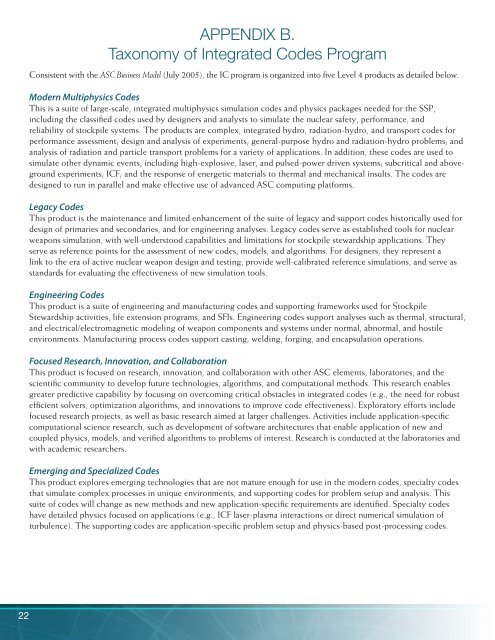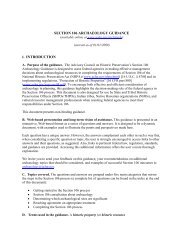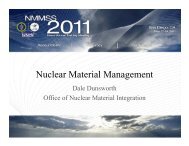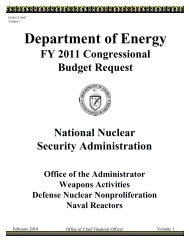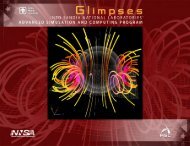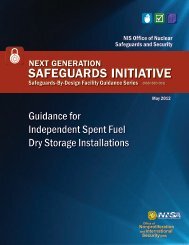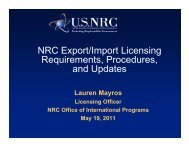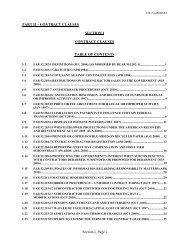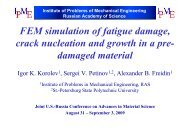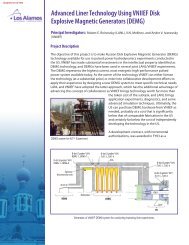ASC Code Strategy - National Nuclear Security Administration
ASC Code Strategy - National Nuclear Security Administration
ASC Code Strategy - National Nuclear Security Administration
Create successful ePaper yourself
Turn your PDF publications into a flip-book with our unique Google optimized e-Paper software.
Appendix B.<br />
Taxonomy of Integrated <strong>Code</strong>s Program<br />
Consistent with the <strong>ASC</strong> Business Model (July 2005), the IC program is organized into five Level 4 products as detailed below.<br />
Modern Multiphysics <strong>Code</strong>s<br />
This is a suite of large-scale, integrated multiphysics simulation codes and physics packages needed for the SSP,<br />
including the classified codes used by designers and analysts to simulate the nuclear safety, performance, and<br />
reliability of stockpile systems. The products are complex, integrated hydro, radiation-hydro, and transport codes for<br />
performance assessment; design and analysis of experiments; general-purpose hydro and radiation-hydro problems; and<br />
analysis of radiation and particle transport problems for a variety of applications. In addition, these codes are used to<br />
simulate other dynamic events, including high-explosive, laser, and pulsed-power driven systems; subcritical and aboveground<br />
experiments; ICF; and the response of energetic materials to thermal and mechanical insults. The codes are<br />
designed to run in parallel and make effective use of advanced <strong>ASC</strong> computing platforms.<br />
Legacy <strong>Code</strong>s<br />
This product is the maintenance and limited enhancement of the suite of legacy and support codes historically used for<br />
design of primaries and secondaries, and for engineering analyses. Legacy codes serve as established tools for nuclear<br />
weapons simulation, with well-understood capabilities and limitations for stockpile stewardship applications. They<br />
serve as reference points for the assessment of new codes, models, and algorithms. For designers, they represent a<br />
link to the era of active nuclear weapon design and testing, provide well-calibrated reference simulations, and serve as<br />
standards for evaluating the effectiveness of new simulation tools.<br />
Engineering <strong>Code</strong>s<br />
This product is a suite of engineering and manufacturing codes and supporting frameworks used for Stockpile<br />
Stewardship activities, life extension programs, and SFIs. Engineering codes support analyses such as thermal, structural,<br />
and electrical/electromagnetic modeling of weapon components and systems under normal, abnormal, and hostile<br />
environments. Manufacturing process codes support casting, welding, forging, and encapsulation operations.<br />
Focused Research, Innovation, and Collaboration<br />
This product is focused on research, innovation, and collaboration with other <strong>ASC</strong> elements, laboratories, and the<br />
scientific community to develop future technologies, algorithms, and computational methods. This research enables<br />
greater predictive capability by focusing on overcoming critical obstacles in integrated codes (e.g., the need for robust<br />
efficient solvers, optimization algorithms, and innovations to improve code effectiveness). Exploratory efforts include<br />
focused research projects, as well as basic research aimed at larger challenges. Activities include application-specific<br />
computational science research, such as development of software architectures that enable application of new and<br />
coupled physics, models, and verified algorithms to problems of interest. Research is conducted at the laboratories and<br />
with academic researchers.<br />
Emerging and Specialized <strong>Code</strong>s<br />
This product explores emerging technologies that are not mature enough for use in the modern codes, specialty codes<br />
that simulate complex processes in unique environments, and supporting codes for problem setup and analysis. This<br />
suite of codes will change as new methods and new application-specific requirements are identified. Specialty codes<br />
have detailed physics focused on applications (e.g., ICF laser-plasma interactions or direct numerical simulation of<br />
turbulence). The supporting codes are application-specific problem setup and physics-based post-processing codes.<br />
22


